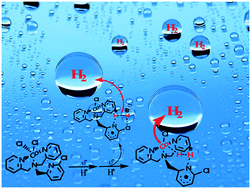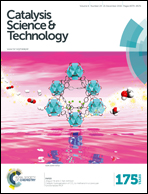A polypyridyl Co(ii) complex-based water reduction catalyst with double H2 evolution sites†
Abstract
A series of Co(II) complexes, Co(X-TMPA)Cl2 (X-TMPA = 1-(6-substituted-pyridin-2-yl)-N,N-bis(pyridin-2-ylmethyl)methane amine, X = Cl (1), Br (2), H (3), and CH3 (4)), were synthesized and fully characterized. The crystal structures of 2 and 4 show that TMPA and CH3-TMPA coordinate to the Co(II) center as tetradentate ligands, while Br-TMPA coordinates as a tridentate ligand, leaving the Br-substituted pyridyl group in the second coordination sphere. All of the complexes are efficient photocatalytic H2 evolution catalysts in CH3CN/H2O (9/1) using [Ir(ppy)2(dtbpy)]Cl (ppy = 2-phenylpyridine, dtbpy = 4,4′-di-tert-butyl-2,2′-bipyridine) as the photosensitizer (PS) and triethylamine (TEA) as the sacrificial electron donor. During 6 h irradiation, the turnover numbers (TONs) of 1 and 2 reached 20 000, remarkably higher than those of 3 and 4. These high photocatalytic activities may be attributed to the pendent Cl/Br-substituted pyridyl group, which serves as a proton and electron relay to facilitate proton reduction at the Co center. Interestingly and importantly, it was found that the Cl-substituted pyridyl group of 1 may catalyze H2 evolution itself by electrocatalytic proton reduction reactions, endowing 1 with double catalytic sites for proton reduction. The unique coordination mode of Cl/Br-TMPA and the double catalytic H2 evolution sites of 1 provide a new strategy to design more effective WRCs.


 Please wait while we load your content...
Please wait while we load your content...